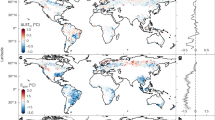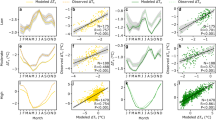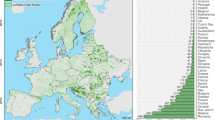Abstract
Forest gain in the tropics can cool the land surface by altering the energy budget through biophysical processes. Many countries have adopted forestation as part of their strategies for tackling climate warming. However, the biophysical effects of forest gain have generally been estimated based on the symmetrical reversal of ongoing tropical forest loss. Here we use multiple sources of satellite remote sensing data to explore the sensitivities of land surface temperature to forest gain and loss, and find forest loss warming the surface by 0.56 ± 0.12 °C and forest gain cooling the surface by 0.10 ± 0.09 °C. This asymmetry indicates weaker biophysical effects of forest gain on local temperature, which we attribute to contrasting changes of vegetation properties, such as leaf area and greenness. We find that current Earth system models fail to capture the observed asymmetry and thus could overestimate the cooling effect of afforestation in future. This highlights the need to improve representation of forest demographic impacts on biophysics-related vegetation properties, such as leaf area index, albedo and canopy structure, to better estimate the effects of tropical forestation on surface temperature.
This is a preview of subscription content, access via your institution
Access options
Access Nature and 54 other Nature Portfolio journals
Get Nature+, our best-value online-access subscription
$29.99 / 30 days
cancel any time
Subscribe to this journal
Receive 12 print issues and online access
$259.00 per year
only $21.58 per issue
Buy this article
- Purchase on Springer Link
- Instant access to full article PDF
Prices may be subject to local taxes which are calculated during checkout




Similar content being viewed by others
Data availability
All data used in the study are open access: MODIS MYD11A2 (https://lpdaac.usgs.gov/products/myd11a2v061/); MODIS MOD11A2 (https://lpdaac.usgs.gov/products/mod11a2v061/); GFCC (https://lpdaac.usgs.gov/products/gfcc30tcv003/); Hansen GFC (https://storage.googleapis.com/earthenginepartners-hansen/GFC-2020-v1.8/download.html); MODIS MOD44B (https://lpdaac.usgs.gov/products/mod44bv061/); MODIS MCD12Q1 (https://lpdaac.usgs.gov/products/mcd12q1v061/); ESA CCI land cover (http://maps.elie.ucl.ac.be/CCI/viewer/download.php); Hilda+ land cover (https://doi.pangaea.de/10.1594/PANGAEA.921846); GlobeLand30 (https://www.cnopendata.com/en/data/m/meteorological/china-globeLand30.html); SRTMGL3 (https://lpdaac.usgs.gov/products/srtmgl3v003/); MODIS MYD15A2H (https://lpdaac.usgs.gov/products/myd15a2hv061/); MODIS MCD43A4 (https://lpdaac.usgs.gov/products/mcd43a4v061/); MODIS MYD13A1 (https://lpdaac.usgs.gov/products/myd13a1v061/); MODIS MYD16A2 (https://lpdaac.usgs.gov/products/myd16a2v006/); MODIS MCD43A3 (https://lpdaac.usgs.gov/products/mcd43a3v061/); GEDI forest canopy height (https://glad.umd.edu/dataset/gedi/); AGB from ref. 28 (https://doi.org/10.5281/zenodo.6103053); and CMIP6 (https://esgf-node.llnl.gov/search/cmip6/). Source data are provided with this paper.
Code availability
The codes used to analyse data and create the figures are available via figshare at https://doi.org/10.6084/m9.figshare.25239877 (ref. 66). All the processing codes are available from the corresponding author on request.
References
Griscom, B. W. et al. Natural climate solutions. Proc. Natl Acad. Sci. USA 114, 11645–11650 (2017).
Law, B.E. et al. Land use strategies to mitigate climate change in carbon dense temperate forests. Proc. Natl Acad. Sci. USA 115, 3663–3668 (2018).
Bonan, G. B. Forests and climate change: forcings, feedbacks, and the climate benefits of forests. Science 320, 1444–1449 (2008).
Friedlingstein, P. et al. Global carbon budget 2021. Earth Syst. Sci. Data 14, 1917–2005 (2022).
Pan, Y. et al. A large and persistent carbon sink in the world’s forests. Science 333, 988–993 (2011).
Lawrence, D. & Vandecar, K. Effects of tropical deforestation on climate and agriculture. Nat. Clim. Change 5, 27–36 (2015).
Devaraju, N., de Noblet-Ducoudré, N., Quesada, B. & Bala, G. Quantifying the relative importance of direct and indirect biophysical effects of deforestation on surface temperature and teleconnections. J. Clim. 31, 3811–3829 (2018).
Duveiller, G., Hooker, J. & Cescatti, A. The mark of vegetation change on Earth’s surface energy balance. Nat. Commun. 9, 679 (2018).
Li, Y. et al. Local cooling and warming effects of forests based on satellite observations. Nat. Commun. 6, 6603 (2015).
Wickham, J. D., Wade, T. G. & Riitters, K. H. Comparison of cropland and forest surface temperatures across the conterminous United States. Agric. For. Meteorol. 166–167, 137–143 (2012).
Wickham, J. D., Wade, T. G. & Riitters, K. H. Empirical analysis of the influence of forest extent on annual and seasonal surface temperatures for the continental United States. Glob. Ecol. Biogeogr. 22, 620–629 (2013).
Alkama, R. & Cescatti, A. Biophysical climate impacts of recent changes in global forest cover. Science 351, 600–604 (2016).
Lee, X. et al. Observed increase in local cooling effect of deforestation at higher latitudes. Nature 479, 384–387 (2011).
Zhang, M. et al. Response of surface air temperature to small-scale land clearing across latitudes. Environ. Res. Lett. 9, 034002 (2014).
Lean, J. & Warrilow, D. A. Simulation of the regional climatic impact of Amazon deforestation. Nature 342, 411–413 (1989).
Betts, R. A. Afforestation cools more or less. Nat. Geosci. 4, 504–505 (2011).
Hansen, M. C. et al. High-resolution global maps of 21st-century forest cover change. Science 342, 850–853 (2013).
Song, X.-P. et al. Global land change from 1982 to 2016. Nature 560, 639–643 (2018).
Winckler, J. et al. Different response of surface temperature and air temperature to deforestation in climate models. Earth Syst. Dyn. 10, 473–484 (2019).
Hansen, M. C., Stehman, S. V. & Potapov, P. V. Quantification of global gross forest cover loss. Proc. Natl Acad. Sci. USA 107, 8650 (2010).
Asner, G. P. et al. Selective logging in the Brazilian Amazon. Science 310, 480–482 (2005).
Jassal, R. S., Black, T. A., Spittlehouse, D. L., Brümmer, C. & Nesic, Z. Evapotranspiration and water use efficiency in different-aged Pacific Northwest Douglas-fir stands. Agric. For. Meteorol. 149, 1168–1178 (2009).
Deng, J., Yao, J., Zheng, X. & Gao, G. Transpiration and canopy stomatal conductance dynamics of Mongolian pine plantations in semiarid deserts, Northern China. Agric. Water Manag. 249, 106806 (2021).
Devaraju, N., Bala, G. & Nemani, R. Modelling the influence of land-use changes on biophysical and biochemical interactions at regional and global scales. Plant Cell Environ. 38, 1931–1946 (2015).
Yang, F. et al. Improved fine-scale tropical forest cover mapping for Southeast Asia using Planet-NICFI and Sentinel-1 Imagery. J. Remote Sens. 3, 0064 (2023).
Cohn, A. S. et al. Forest loss in Brazil increases maximum temperatures within 50 km. Environ. Res. Lett. 14, 084047 (2019).
Potapov, P. et al. Mapping global forest canopy height through integration of GEDI and Landsat data. Remote Sens. Environ. 253, 112165 (2021).
Hua, F. et al. The biodiversity and ecosystem service contributions and trade-offs of forest restoration approaches. Science 376, eabl4649 (2022).
IPCC Special Report on Global Warming of 1.5 °C (eds Masson-Delmotte, V. et al.) (WMO, 2018).
Eyring, V. et al. Overview of the Coupled Model Intercomparison Project Phase 6 (CMIP6) experimental design and organization. Geosci. Model Dev. 9, 1937–1958 (2016).
Ge, J. et al. Evaluation of coupled regional climate models in representing the local biophysical effects of afforestation over continental China. J. Clim. 34, 9879–9898 (2021).
Xu, Z., Mahmood, R., Yang, Z.-L., Fu, C. & Su, H. Investigating diurnal and seasonal climatic response to land use and land cover change over monsoon Asia with the Community Earth System Model. J. Geophys. Res. Atmos. 120, 1137–1152 (2015).
Winckler, J., Reick, C. H., Bright, R. M. & Pongratz, J. Importance of surface roughness for the local biogeophysical effects of deforestation. J. Geophys. Res. Atmos. 124, 8605–8618 (2019).
Pastor, A. V. et al. The global nexus of food–trade–water sustaining environmental flows by 2050. Nat. Sustain. 2, 499–507 (2019).
Yao, G., Zhang, X., Davidson, E. A. & Taheripour, F. The increasing global environmental consequences of a weakening US–China crop trade relationship. Nat. Food 2, 578–586 (2021).
Betts, R. A. Offset of the potential carbon sink from boreal forestation by decreases in surface albedo. Nature 408, 187–190 (2000).
Li, Y. et al. Potential and actual impacts of deforestation and afforestation on land surface temperature. J. Geophys. Res. Atmos. 121, 14372–14386 (2016).
Su, Y. et al. Asymmetric influence of forest cover gain and loss on land surface temperature. Nat. Clim. Change 13, 823–831 (2023).
Cunningham, D., Cunningham, P. & Fagan, M. E. Identifying biases in global tree cover products: a case study in Costa Rica. Forests 10, 853 (2019).
Sannier, C., McRoberts, R. E. & Fichet, L.-V. Suitability of global forest change data to report forest cover estimates at national level in Gabon. Remote Sens. Environ. 173, 326–338 (2016).
Lwin, K. K., Ota, T., Shimizu, K. & Mizoue, N. Assessing the importance of tree cover threshold for forest cover mapping derived from global forest cover in Myanmar. Forests 10, 1062 (2019).
García, P. R., Scaccia, L. & Salvati, L. An accuracy assessment of three forest cover databases in Colombia. Environ. Ecol. Stat. 30, 443–475 (2023).
Tropek, R. et al. Comment on ‘High-resolution global maps of 21st-century forest cover change’. Science 344, 981–981 (2014).
Gomes, L. et al. Agricultural expansion in the Brazilian Cerrado: increased soil and nutrient losses and decreased agricultural productivity. Land 8, 12 (2019).
Rausch, L. L. et al. Soy expansion in Brazil’s Cerrado. Conserv. Lett. 12, e12671 (2019).
Anderson-Teixeira, K. J. et al. Altered dynamics of forest recovery under a changing climate. Glob. Change Biol. 19, 2001–2021 (2013).
Chua, S. C., Ramage, B. S., Ngo, K. M., Potts, M. D. & Lum, S. K. Y. Slow recovery of a secondary tropical forest in Southeast Asia. For. Ecol. Manag. 308, 153–160 (2013).
Poorter, L. et al. Multidimensional tropical forest recovery. Science 374, 1370–1376 (2021).
Tang, J., Luyssaert, S., Richardson, A. D., Kutsch, W. & Janssens, I. A. Steeper declines in forest photosynthesis than respiration explain age-driven decreases in forest growth. Proc. Natl Acad. Sci. USA 111, 8856–8860 (2014).
Winckler, J., Reick, C. H. & Pongratz, J. Robust identification of local biogeophysical effects of land-cover change in a global climate model. J. Clim. 30, 1159–1176 (2017).
Winckler, J., Lejeune, Q., Reick, C. H. & Pongratz, J. Nonlocal effects dominate the global mean surface temperature response to the biogeophysical effects of deforestation. Geophys. Res. Lett. 46, 745–755 (2019).
Pitman, A. J. et al. Importance of background climate in determining impact of land-cover change on regional climate. Nat. Clim. Change 1, 472–475 (2011).
Wan, Z. New refinements and validation of the collection-6 MODIS land-surface temperature/emissivity product. Remote Sens. Environ. 140, 36–45 (2014).
Hansen, M. C., Townshend, J. R. G., DeFries, R. S. & Carroll, M. Estimation of tree cover using MODIS data at global, continental and regional/local scales. Int. J. Remote Sens. 26, 4359–4380 (2005).
Ciemer, C. et al. Higher resilience to climatic disturbances in tropical vegetation exposed to more variable rainfall. Nat. Geosci. 12, 174–179 (2019).
Sulla-Menashe, D., Gray, J. M., Abercrombie, S. P. & Friedl, M. A. Hierarchical mapping of annual global land cover 2001 to present: the MODIS Collection 6 land cover product. Remote Sens. Environ. 222, 183–194 (2019).
Friedl, M. A. et al. MODIS Collection 5 global land cover: algorithm refinements and characterization of new datasets. Remote Sens. Environ. 114, 168–182 (2010).
Li, W. et al. Gross and net land cover changes in the main plant functional types derived from the annual ESA CCI land cover maps (1992–2015). Earth Syst. Sci. Data 10, 219–234 (2018).
Winkler, K., Fuchs, R., Rounsevell, M. & Herold, M. Global land use changes are four times greater than previously estimated. Nat. Commun. 12, 2501 (2021).
Chen, J., Ban, Y. & Li, S. Open access to Earth land-cover map. Nature 514, 434–434 (2014).
Yan, K. et al. Evaluation of MODIS LAI/FPAR product Collection 6. Part 1: consistency and improvements. Remote Sens. 8, 359 (2016).
Yan, K. et al. Evaluation of MODIS LAI/FPAR product Collection 6. Part 2: validation and intercomparison. Remote Sens. 8, 460 (2016).
Zhang, J. et al. NIRv and SIF better estimate phenology than NDVI and EVI: effects of spring and autumn phenology on ecosystem production of planted forests. Agric. For. Meteorol. 315, 108819 (2022).
Liu, H. Q. & Huete, A. A feedback based modification of the NDVI to minimize canopy background and atmospheric noise. IEEE Trans. Geosci. Remote Sens. 33, 457–465 (1995).
Mu, Q., Zhao, M. & Running, S. W. Improvements to a MODIS global terrestrial evapotranspiration algorithm. Remote Sens. Environ. 115, 1781–1800 (2011).
Zhang, Y. MATLAB Code (NGS-2023-06-01134A). figshare https://doi.org/10.6084/m9.figshare.25239877.v2 (2024).
Acknowledgements
This study was supported by the National Key R&D Program of China (grant no. 2019YFA0607302) and the National Natural Science Foundation of China (grant no. 42171096). We also acknowledge the support by the High-performance Computing Platform of Peking University.
Author information
Authors and Affiliations
Contributions
X.W. designed the research. Y.Z. performed analyses and drafted the figures. Y.Z., X.W. and X.L. wrote the manuscript with help from S.L., Y.L., C.C. and S.P. All authors contributed to the interpretation of the results.
Corresponding author
Ethics declarations
Competing interests
The authors declare no competing interests.
Peer review
Peer review information
Nature Geoscience thanks Edouard Davin, Shruti Nath and the other, anonymous, reviewer(s) for their contribution to the peer review of this work. Primary Handling Editor: Tom Richardson, in collaboration with the Nature Geoscience team.
Additional information
Publisher’s note Springer Nature remains neutral with regard to jurisdictional claims in published maps and institutional affiliations.
Supplementary information
Supplementary Information
Supplementary text, Figs. 1–41 and Tables 1–5.
Source data
Source Data Fig. 1
Statistical source data.
Source Data Fig. 2
Statistical source data.
Source Data Fig. 3
Statistical source data.
Source Data Fig. 4
Statistical source data.
Rights and permissions
Springer Nature or its licensor (e.g. a society or other partner) holds exclusive rights to this article under a publishing agreement with the author(s) or other rightsholder(s); author self-archiving of the accepted manuscript version of this article is solely governed by the terms of such publishing agreement and applicable law.
About this article
Cite this article
Zhang, Y., Wang, X., Lian, X. et al. Asymmetric impacts of forest gain and loss on tropical land surface temperature. Nat. Geosci. 17, 426–432 (2024). https://doi.org/10.1038/s41561-024-01423-3
Received:
Accepted:
Published:
Issue Date:
DOI: https://doi.org/10.1038/s41561-024-01423-3



